This post may contain affiliate links. Please read our disclosure policy.
Lebanese pickled turnips are the little pink slices wrapped up in you Middle Eastern wraps like shawarma. They get their pink hue from a beet in the jar! They are versatile, delicious on their own and with other pickles. This is an easy recipe for refrigerator pickles, no canning necessary.
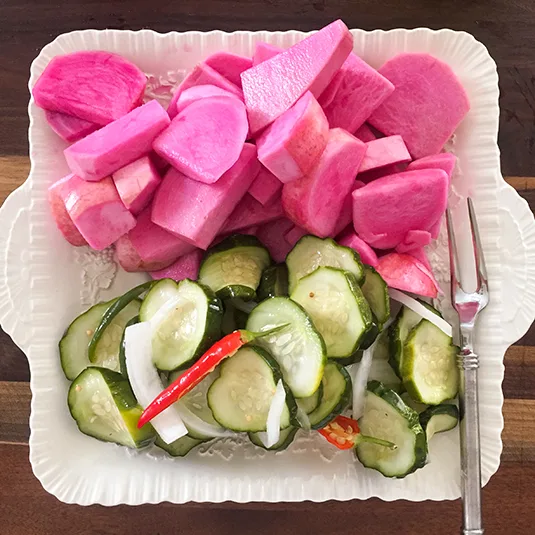
Lebanese pink pickled turnips are a Lebanese favorite that evoke soooo many memories and so much family feel for me. My Aunt Hilda made turnip pickles often, never without lots of jars to share with all of us. She enjoyed a lot of heat in her pickles, so many of her pickle jars were loaded with garlicky heat. Read one of my first post stories about Aunt Hilda and her turnip pickles here.
Table of Contents
Why you’ll love Lebanese turnip pickles
Lebanese pickled turnips, also called “lift,” are the pink pickles that fans of Middle Eastern food see peeking out from your shawarma wrap! They get their pink hue from a slice of red beet included in the jar with the turnips. This Middle Eastern staple can be eaten different ways: on its own as any pickled root vegetable, wrapped in a sandwich, or as part of an assortment of crunchy condiments and olives on the dinner table.
They are a simple, quick pickling addition to your pickle repertoire, easy to make and a great way to enjoy flavor at the ready in the fridge.
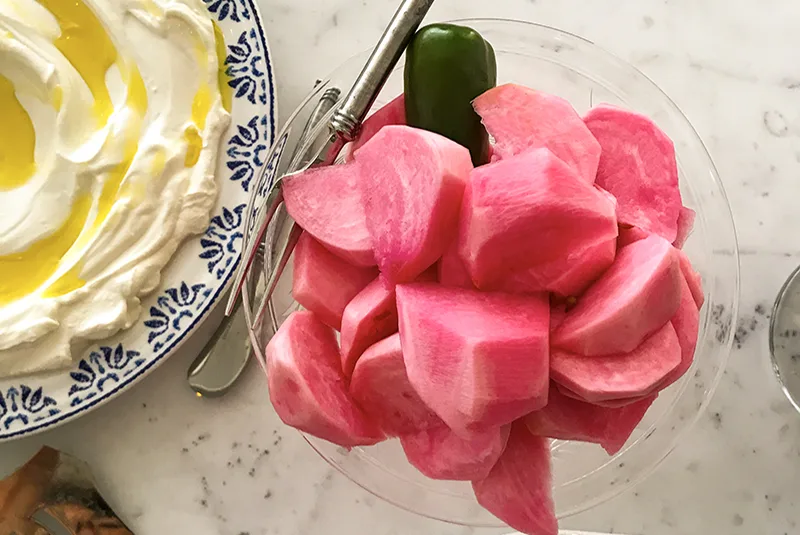
What do you eat with Lebanese pickles?
There are limitless possibilities of what to eat with these pretty pink pickles. Serve them alongside chicken shawarma, tossed with green beans, on top of falafel wraps (or pita wraps), as for crunch with a spread like baba ganoush or hummus, or as a snack like regular old crunchy pickles!
Just slice the pickles into thin sticks to add them to wraps.
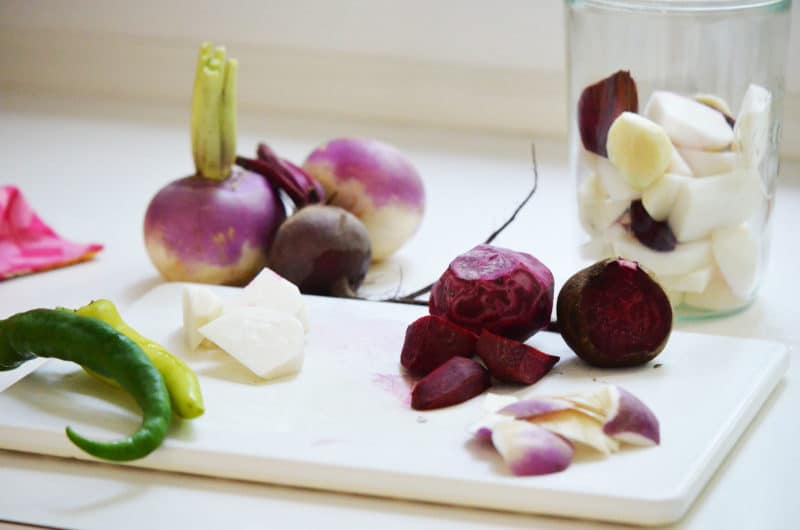
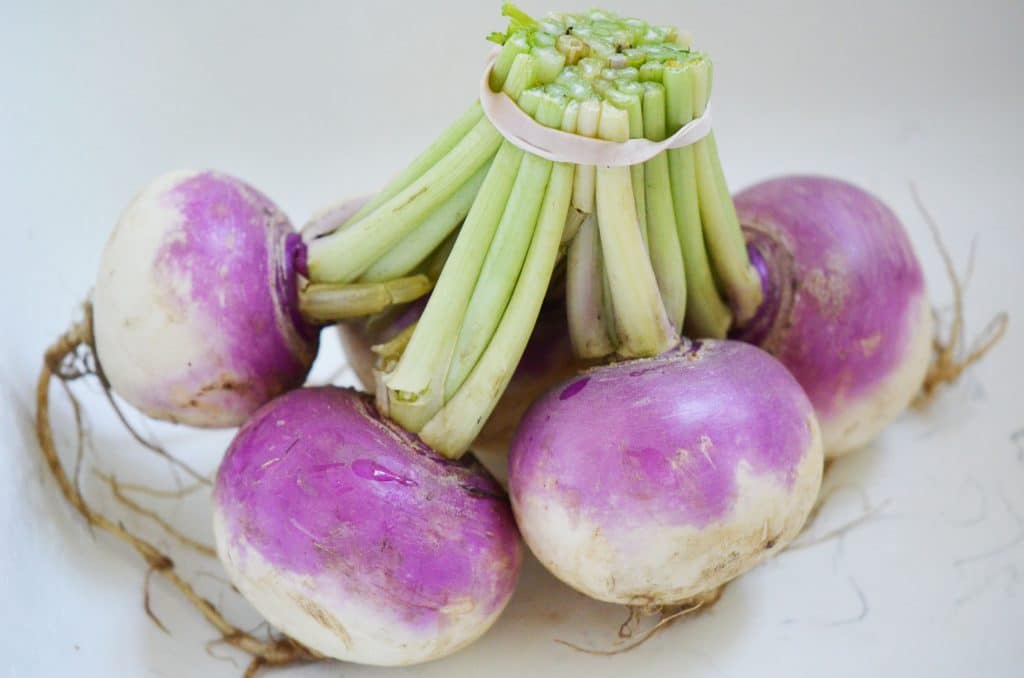
Ingredients to make Lebanese pink pickled turnips
White vinegar. This is the best type to use, but apple cider vinegar, sweet vinegar, or white wine vinegar would do the job in a pinch.
Cold water. Cold water will be part of the pickling brine as it will balance out the vinegar.
Kosher salt. Be sure to use a good amount of salt, and make sure it’s kosher salt. Table salt will make the pickling solution very bitter.
White turnips. I prefer white turnips for this recipe, both for the taste and the color they take on from the beet. Large turnips work best; small ones are fine, just buy more of them to fill the jar.
Beet. One red beet, trimmed and peeled, will yield pink turnips. I love the gorgeous pink color! Two really small beets also do the job.
Garlic. I use three cloves of garlic, peeled. Use as many or as few as you’d like depending on how garlicky you like your pickle brine.
Jalapeño. These are a delicious way to get some heat on your pickled turnips. Like the garlic, you can control a sharper flavor or mild flavor by cutting the ribs and seeds out of the jalapeño, or leaving them!
Pickling spice. You will find pickling spice in most grocery stores. Go with personal preferences in terms of using it or not, but the spice comes alive with the fermentation process and gives a tangy flavor.
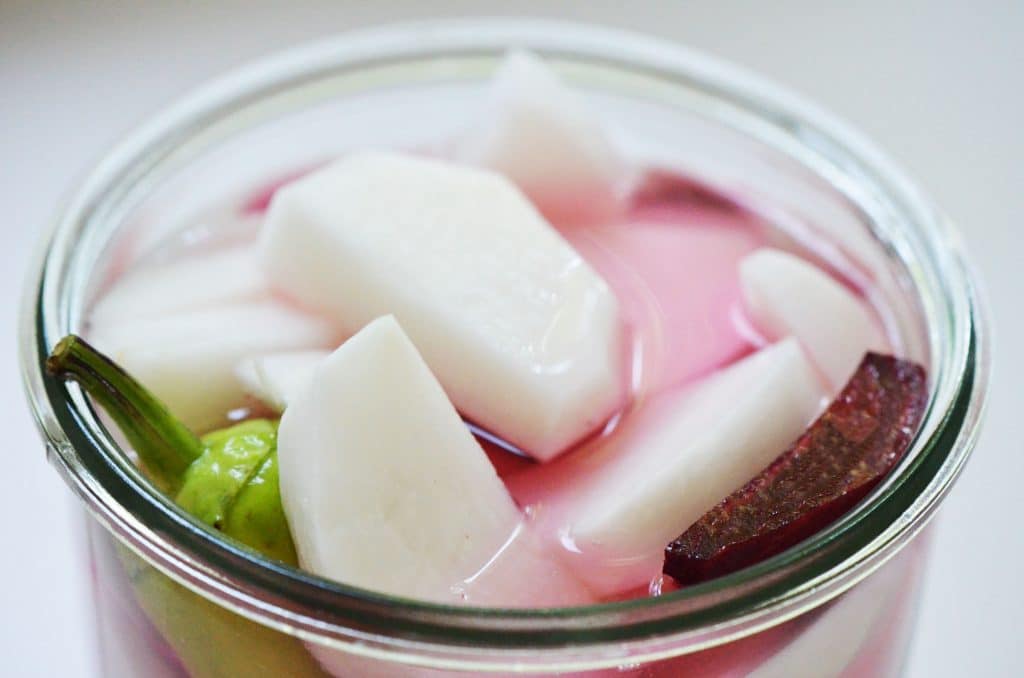
How to make the brine
In a small bowl, combine the vinegar, water, and salt to make a quick brine. Let the mixture sit for a few minutes, stirring occasionally until the salt is dissolved.
How to pickle the turnips
Step 1. Cut the turnips and beet from top to bottom, and then into ½-inch thick wedges. Pierce the jalapeño with a sharp knife for mild heat, or cut it in half lengthwise to expose the seeds and ribs for more heat.
Step 2. Pack the turnips and beets tightly into a quart-sized glass jar, put the garlic cloves in at the top of the jar, tucking in the jalapeño as you go. Add the pickling spice. Leave about an inch of space at the top above the brine.
Step 3. Pour the brine into the jar, and leaving an inch headspace on top, close it with a tight-fitting lid. Refrigerate for three days or up to a couple of weeks. Shake the jar occasionally at first to distribute the gorgeous pop of color from the beet.
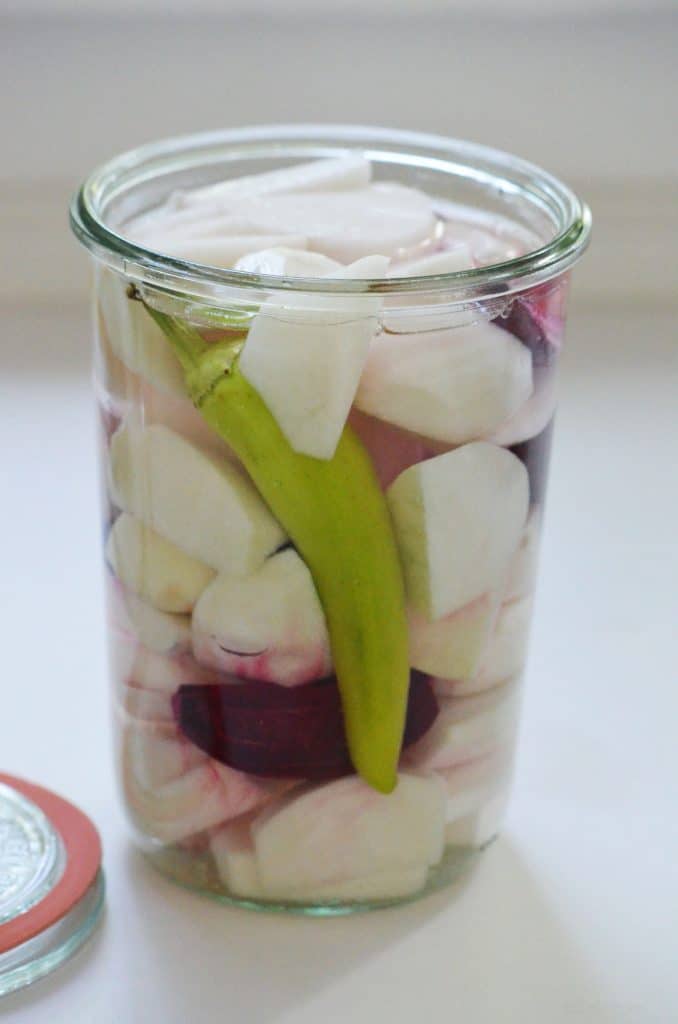
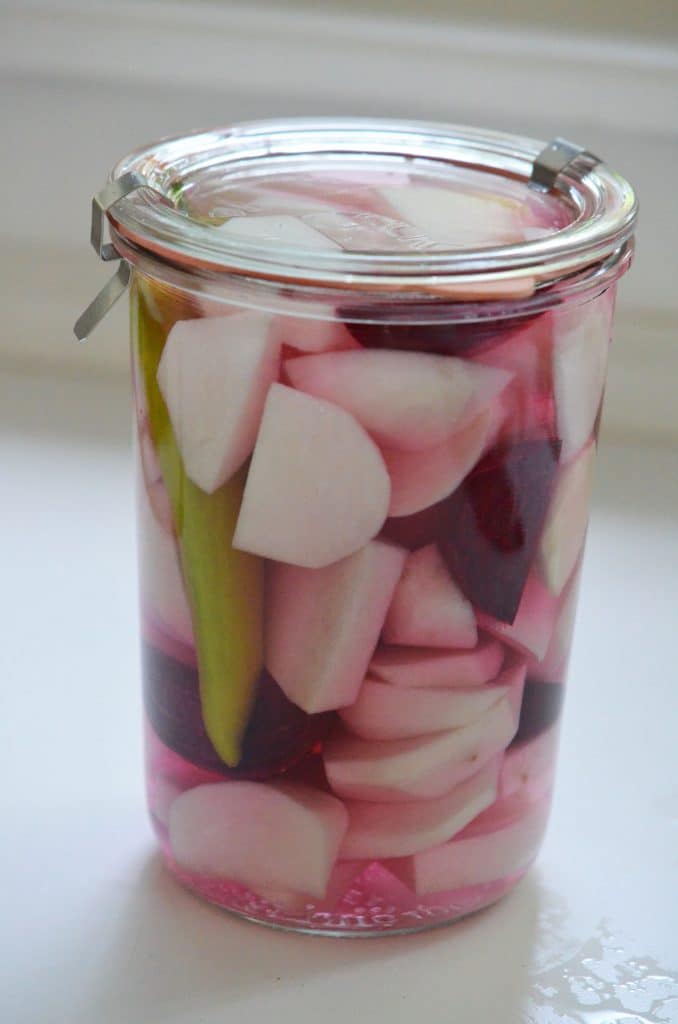

Variations to try
Use different herbs or aromatics instead of pickling spice to change up the flavor profile of the turnips recipe. You can try bay leaves (one bay leaf per jar is plenty), and fresh herbs to accomplish this.
Try different ways of making your quick pickles spicy. Jalepeño, red peppers or red chili are great avenues to heat.
Some like to boil the vinegar mixture before putting it in a jar with the crunchy vegetable. To do this, add the vinegar and cold water to a small saucepan over medium heatl. Make sure to allow the mixture to return to room temperature before pouring it into the jar.
Golden beets will result in a more yellow pickle, not pink, but they are still delicious!
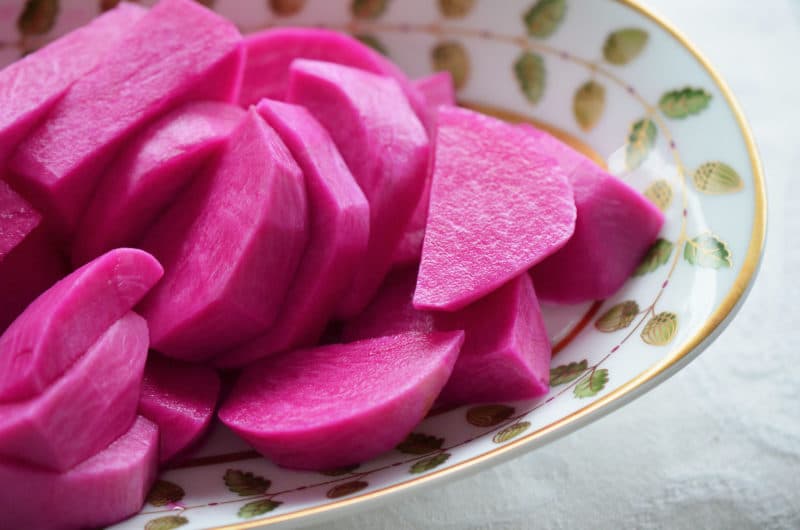
Frequently Asked Questions
The beet! Cut into thin slices and put into the jar along with the vinegar salt water, will give regular turnips a beautiful color.
Yes! This refrigerator pickle is great for contributing to your daily values of several different nutrients like vitamin c, filling and satisfying for those on a low calorie diet or other special diets, and supports gut health.
Yes, although the homemade version is even more delicious (better texture, crunchier), requires no special equipment, and is easy for a first time pickler, you can get jarred pickled turnips next time you’re at your local Middle Eastern market or Middle Eastern restaurants.
Turnips can absolutely be fermented, it will result in a different kind of pickles. If this is your plan, avoid using a smaller jar so that the turnips, and the rest of the ingredients, are not too tightly packed. Fermenting turnips is different from pickling because the mixture is just salt and a couple cups of water. No vinegar!
Store the jar of turnips in a dark place and they will be fermented in approximately 5-7 days.
They can be stored in the pickling jar at room temperature in a dark place for about a month if jarred for shelf life. Refrigerate once opened. Refrigerator pickles that have not been canned with sterilization and heat should be stored in the refrigerator.
More Pickle Recipes
Asparagus Pickles with Grape Leaves
Bread and Butter Sweet Pickle Chips
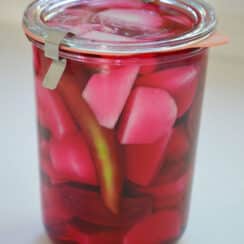
Lebanese Turnip Pickles
Ingredients
- 1 cup distilled white vinegar
- 1/2 cup cold water
- 1 1/2 tablespoons kosher salt
- 1 1/4 pounds white turnips, tipped, tailed, peeled
- 1 small beet, trimmed and peeled
- 3 cloves garlic, peeled
- 1 jalapeno pepper (optional), or 1 teaspoon red chili pepper flakes (optional)
- 1 teaspoon pickling spice
Instructions
- In a small bowl, combine the vinegar, water, and salt to make a brine. Let the mixture sit for a few minutes, stirring occasionally until the salt is dissolved.
- Cut the turnips and beet in half from top to bottom, and then into 1/2-inch thick wedges. Pierce the jalapeno with a knife for mild heat, or cut it in half lengthwise to expose the seeds and ribs for more heat.
- Pack the turnips and beets into a quart jar layered with the garlic cloves, tucking in the hot pepper next to the glass as you go (it’s pretty that way). Top with hot pepper flakes (if using instead of the jalapeno) and the pickling spice.
- Pour the brine into the jar, leaving about 1/2-inch headspace. Top the jar with a lid and refrigerate for at least 3 days and up to a couple of months, shaking the jar occasionally at first to distribute the pink hue of the beet.
Video
Nutrition
Nutrition information is automatically calculated, so should only be used as an approximation.
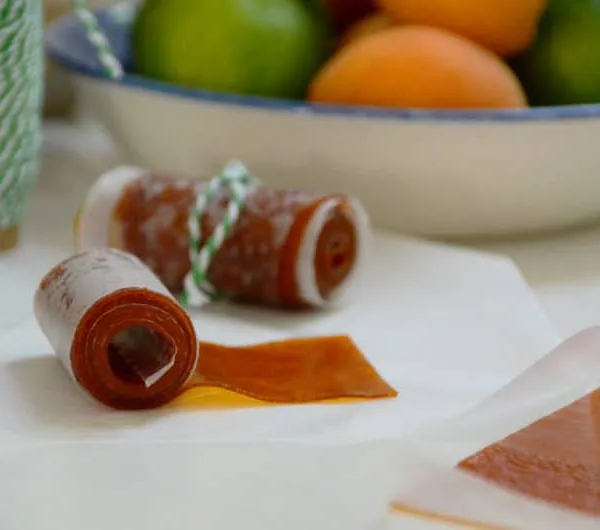
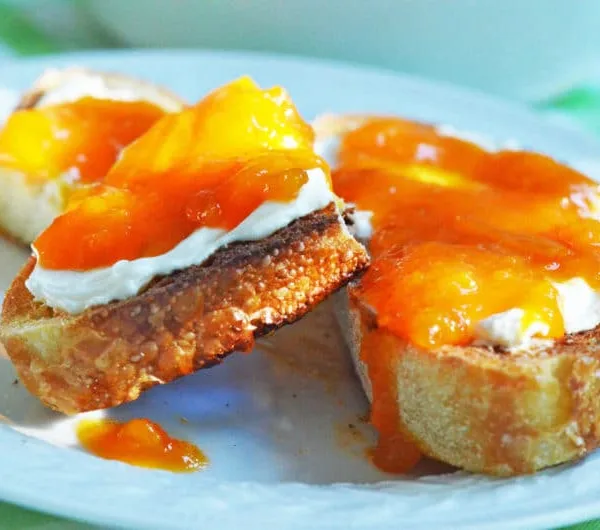
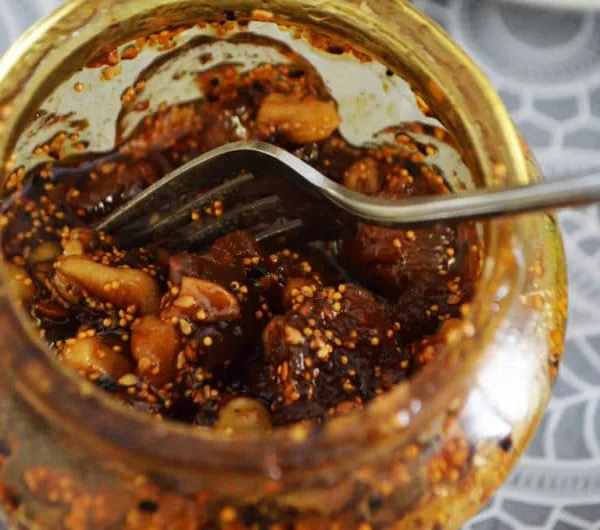








Dear Maureen – Couldn’t resist your PINK!!! turnip pickle recipe. Made a batch near Christmas exactly following your recipe (minus the jalapeno, though if making only for me I would amp up the heat); SO EASY! It was fun to shake the jar every day and see the pink color develop. Festive as well as delicious. Made more since then. Can’t help smiling every time I open the fridge and see them!
Kim I love how you’ve captured this!! These pickles sure are for a smile!
Maureen, many thanks for the turnip pickle recipe. I had forgotten how my mom prepared it. It was great to find your recipe. I like your new website, and I especially like the word HABIBI.
Good luck to you always and I hope you have many sales and a very successful and busy season.
Fadia
fadiahouse@gmail.com
Thanks so very much Habibi!
This is one of my favorite of your posts. Not for the recipe, but for the story of the feast at a most certainly difficult time for your family. Uncle Fred has an incredible family and Aunt Hilda is a saint.
Thank you so much Chris. Truth.
Maureen, my sithee used to make lift, but let the jars sit for a couple of days in her pantry before refrigerating because they got their color faster. Is that a good idea?
Who am I to question a Sitee?! Yet…I would not leave refrigerator pickles out at all. I find the pink hue happens swiftly anyway! With all due respect to our Sittees!
Which pickling spice do you use in the recipe?
Hi Ren–there is typically a basic, standard “pickling spice” you’ll find at any grocery store, under all major spice brands. This is what I use!
Maureen,
Perhaps I missed the info, but how much jar space do I need for the quantity of turnips/beets in your recipe (oops! Aunt Hilda’s recipe)? I don’t have pickling jars, so I have to go buy them. But, I don’t know what kind to buy, how many I should buy, and what size they should be. Apologies for my ignorance (I’m a pickling newbie!).
Hi David–great questions. I use a wide variety of jar sizes (whatever I have on hand) and I don’t worry too much about whether I fill the jar or not if it’s a larger jar. That said, this recipe is for one quart jar using just over a pound of turnips. You can easily scale up and make more at one time in several jars. Leave about 1/2-inch headspace. Also note that these are refrigerator pickles, not processed for shelf life. Let me know any other questions whatsoever! I’m happy you’re doing this!
You write beautifully, thank you.
Thank you so much, Helen!
I grew up in Damas, n i loved all our pickles, lift n especially makdous. I have an american restaurant in the vail co. area. I have a tapa/ mezze menu at the bar. Your taunts recipe is the basis for my lift. Of all the recipes i researched on line yours was the best, so i copied it and now serve it in my restaurant. Thank you for shareing it n thank you for the beautifully well written story that came with it.
Alla yah teekon al aafia
I found this recipe after searching for something to do with some baby turnips I received. I’m glad I made them; they were delicious! Thanks for the recipe!
When I started walking to Kindergarten, Mom allowed me to visit my best friend who lived around the block after school. Lisa’s family was Lebanese and I always felt warmed by the open affection in their home. I was a skinny child, so of course they offered me wonderful food every time I visited. Your story about Aunt Hilda reminds me of those happy times I spent with them.
I got a late start planting this year, so my garden has turnips, beets, and banana peppers ready to harvest right now…Time to introduce my family to these. My Nephew is having a party to celebrate the 1st birthday of his long awaited daughter(after 3 boys)…The perfect occasion! The boys love all my other pickle recipes.
Pat, great memories! And it’s so nice to hear you are hoping to share Lebanese cuisine with your family and to celebrate baby girl!
Aunt Hilda was an amazing woman. I can almost hear her voice from your description! She taught me how to make hushwi when I was in high school (*many* years ago), and I have had the recipe since, but never actually made it- until about a month ago… it was exactly as wonderful as I remember my mom making it when I was very little. Thank you for this, and all of your other recipes and posts. It brings me vivid memories of a part of my childhood I don’t often have the pleasure of reminiscing about…
Emily, cousin, you and your family are often in my thoughts. It is so good to hear from you and to know that, as for all of us, our Lebanese kitchen ties us to those we love and miss so dearly.
My dear Mother always pickled turnips and always
with a beet for the color-thank you for these precious
memories your words and pis always evoke!
What was your mother’s name, Diane? I imagine her as a sheer force of a woman on many levels!
This is such a wonderful post! In my family, food is the the main way we express love and affection, and this is such a beautiful example of that.
I came here looking for a great pickled turnip recipe, now I’m filled with the overwhelming urge to call my mom…
Ahhh Elaine, that is what it’s all about, isn’t it. Thank you for your kind, kind words.
i would like to discover your blog just found it as i was looking for turnips recipe!
God bless
Welcome!
What a beautiful blog. I’m glad I found it. I look forward to hearing more about your family and food.
Thank you so much! Welcome!
Dear Maureen – I loved this story so much that I made the Lift and the Apricot preserves are simmering on the stove as I type this. What a heavenly smell is filling my kitchen!! Thank you for sharing and inspiring. The color of the lift is the most beautiful shade of pink 🙂
That is wonderful Brian, thank you so much! We ate ALL of our first batch this past week; making more today (just can’t get enough!)!
hi there, i love your stories and your passion for middle eastern food,i was introduced to lebanese food thirty odd years ago and really love it,i was taught how to make some things the traditional way,that is without any machines,i find this way very peaceful,no screaming motors……anyway i was wondering about how much salt for the pickled turnips as it says 4 t salt,not sure if it means teespoons or tablespoons,anyhow thanking you so much for for your great web site…..i wish you were not married cheers john the kiwi
Thank you John! Your name intrigues me because my mother has relatives with that same last name from Ohio, U.S. For the turnips, that’s 4 teaspoons salt–enjoy your lifft!
Good morning Maureen:
I love fresh turnips but only fix them one way and that is boiled and mashed like mashed potatoes. I am happy to see turnips enjoyed a different way. I can’t wait to try this recipe.
Thanks so much for all your wonderful stories and recipes.
I agree with all those posts….and sad it is on one hand because we miss Hilda soooo much, and joyous that we know she is dining with her brothers and sister and my mom…..Mom and Hilda got along famously.
I hope you realize that it is not only the food that whets our palettes, but the stories of home and beyond.
Love to you always,
Janet
Janet, I couldn’t agree more. Aunt Hilda, your mom, all of our beloveds, they are blessed with peace in heaven. I remember how much Aunt Hilda loved your mother.
I can’t tell you how happy I am that you are writing this blog. On those earlier occasions when I’d read something you’d written, I was always blown away. Now you’re really going for it, and we are all the beneficiaries.
You rock, Sofia! Thank you thank you….
Maureen, this was a beautiful, yet sad story, but you write so elegantly I feel as though I was there. Yesterday my mother and I made coosa because of last week’s blog. I couldn’t get it out of my mind. When I saw cousin Jim last night at Sandy’s service he reminded me of a secret ingredient to put in the meat mixture and that’s a pinch of cayenne. He also mentioned that Aunt Hilda would put a bay leaf into her simmering pot of coosa. I will add these secrets to my next batch. Thank you for your writings, it brings joy to many. Love to all, Rachel
Rachel, thank you for your words and I am so glad to hear those wonderful ways to deepen the flavor of the coosa and its tomato sauce!
I was smiling reading this story because it seemed so familiar to me; so many Lebanese family have an aunt Hilda; her name is so evocative of traditional lebanese families, with food food aplenty and lots of relatives and conviviality. I love pickled turnips and need to make some! Yours are my style too, with garlic and chili both!
Aunt Hilda has such life, such an ability to strengthen the family through her spirit and her food. She’s one of my favorite members of your written family. The pickled turnips look great, Maureen.
Maureen- Mary turned me on to your blog & I have to admit, I wait anxiously for it to arrive in my inbox. Thanks for drawing me in! Maybe I’ll even try a recipe or two 😉 My best to you and Peg. Please tell her hello for me!
Great to hear from you Linda!! Thank you for reading and hope you are all doing well…and I hope our paths cross again someday soon!
Maurine, I have many Mediterranean cook books, but yours is at the top of my list.My Sittie (grandmother). did the cooking in the house. Your recipes are all just like hers that I grew up with. It was a bright day in my life when I found your site. Keep spoiling us with your generous recipes. In the meantime, I
have your book, and can enjoy the foods familiar to me
Vivian, how kind and how nice to hear, thank you so much! I’m honored!
Hello Maureen,
What type of pickling spice do you use ?
Thank you
Hi Valeria, I use any brand available at my local grocery store as this is a standard spice blend labeled as “Pickling Spice.” It includes allspice, cardamom, cinnamon, cloves, coriander, ginger, mustard seeds, and peppercorns.
these look fabulous – I will have to try them!